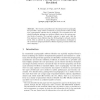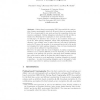73
Voted
CCS
2010
ACM
15 years 1 months ago
2010
ACM
Secure "pairing" of wireless devices based on auxiliary or out-ofband (OOB)
161
click to vote
CIS
2006
Springer
15 years 4 months ago
2006
Springer
Pairing-based cryptosystems (PBC) have been attracted by researchers in cryptography. Some implementations show that PBC are relatively slower than the standard public key cryptosy...
122
Voted
CANS
2006
Springer
15 years 4 months ago
2006
Springer
Pairings on elliptic curves have been used as cryptographic primitives for the development of new applications such as identity based schemes. For the practical applications, it is...
ANTS
2006
Springer
15 years 4 months ago
2006
Springer
The security and performance of pairing based cryptography has provoked a large volume of research, in part because of the exciting new cryptographic schemes that it underpins. We ...
103
Voted
ASIACRYPT
2003
Springer
15 years 6 months ago
2003
Springer
The Weil and Tate pairings have been used recently to build new schemes in cryptography. It is known that the Weil pairing takes longer than twice the running time of the Tate pair...
93
Voted
CRYPTO
2004
Springer
15 years 6 months ago
2004
Springer
Pairing-based cryptosystems rely on bilinear non-degenerate maps called pairings, such as the Tate and Weil pairings defined over certain elliptic curve groups. In this paper we s...
ITICSE
2004
ACM
15 years 6 months ago
2004
ACM
Prior research on pair programming has found that compared to students who work alone, students who pair have shown increased confidence in their work, greater success in CS1, an...
95
Voted
IWSEC
2007
Springer
15 years 7 months ago
2007
Springer
Abstract. Pairing-based cryptography (PBC) has enabled the construction of many cryptographic protocols. However, there are scenarios when PBC is too heavyweight to use, such as wh...
117
Voted
ACNS
2009
Springer
15 years 7 months ago
2009
Springer
Abstract. “Secure Device Pairing” is the process of bootstrapping secure communication between two devices over a short- or medium-range wireless channel (such as Bluetooth, Wi...






